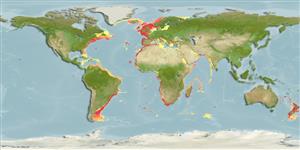Environment: milieu / climate zone / depth range / distribution range
Ecologia
marinhas demersal; oceanódromo (Ref. 51243); intervalo de profundidade 40 - 600 m (Ref. 7251), usually 100 - 200 m (Ref. 36731). Deep-water; 70°N - 55°S, 82°W - 179°E
Eastern Atlantic: Norway to South Africa (Ref. 6633), including the Mediterranean, Canary Islands, Madeira, Cape Verde, and Tristan da Cunha. Western Atlantic: Newfoundland, Canada and Gulf of Maine to North Carolina, USA (Ref. 7251). Recorded from Uruguay to Argentina (Ref. 9050). Western Indian Ocean: St. Paul and Amsterdam islands (Ref. 6633). Southwest Pacific: New Zealand (Ref. 5755, 9072).
Length at first maturity / Tamanho / Peso / Idade
Maturity: Lm 77.9 range ? - 90 cm
Max length : 210 cm TL macho/indeterminado; (Ref. 7251); common length : 80.0 cm TL macho/indeterminado; (Ref. 3397); peso máx. Publicado: 100.0 kg (Ref. 35388); Idade máx. registada: 80 anos (Ref. 127279)
Descrição breve
Chaves de identificação | Morfologia | Morfometria
Espinhos dorsais (total) : 10 - 12; Raios dorsais moles (total) : 11 - 13; Espinhos anais: 3; Raios anais moles: 8 - 10. Bluish grey above, paler below with a silvery sheen; fins blackish brown (Ref. 6633). Juveniles have black blotches on head and body (Ref. 6633). Body tall, compressed. Big mouth with big head and a rough bony ridge across upper part of the gill cover (Ref. 35388).
Adults prefer to inhabit caves and shipwrecks (Ref. 27121). Juveniles congregate below floating objects (Ref. 27121). Usually solitary. Feed on large crustaceans, cephalopods and benthic fishes (Ref. 27121). Spawn in the summer (Ref. 35388). Are primary gonochorists (Ref. 58421). Marketed fresh or frozen; eaten steamed, fried, broiled, boiled, microwaved and baked (Ref. 9988). Minimum depth reported from Ref. 6633.
Primary gonochorists (Ref. 58421).
Wheeler, A., 1992. A list of the common and scientific names of fishes of the British Isles. J. Fish Biol. 41(suppl.A):1-37. (Ref. 5204)
Categoria na Lista Vermelha da IUCN (Ref. 130435)
Ameaça para o homem
Harmless
Utilização humana
Pescarias: pouco comercial; peixe desportivo: sim
Ferramentas
Relatórios especiais
Descarregue XML
Fontes da internet
Estimates based on models
Preferred temperature (Ref.
123201): 5.2 - 19, mean 9.4 °C (based on 672 cells).
Phylogenetic diversity index (Ref.
82804): PD
50 = 0.8125 [Uniqueness, from 0.5 = low to 2.0 = high].
Bayesian length-weight: a=0.01318 (0.00968 - 0.01796), b=3.00 (2.91 - 3.09), in cm total length, based on LWR estimates for this species (Ref.
93245).
Nível Trófico (Ref.
69278): 4.1 ±0.64 se; based on food items.
Resiliência (Ref.
120179): Baixo, tempo mínimo de duplicação da população 4,5 - 14 anos (K=0.05-0.08; tmax=76; tm=9-10 yrs estimated from VBGF; Fec=3 million).
Fishing Vulnerability (Ref.
59153): Very high vulnerability (78 of 100).
Climate Vulnerability (Ref.
125649): Moderate to high vulnerability (50 of 100).
Nutrients (Ref.
124155): Calcium = 9.7 [6.1, 21.1] mg/100g; Iron = 0.354 [0.174, 0.670] mg/100g; Protein = 19.6 [19.0, 20.3] %; Omega3 = 0.427 [0.332, 0.549] g/100g; Selenium = 25 [11, 55] μg/100g; VitaminA = 7.95 [1.81, 35.92] μg/100g; Zinc = 0.253 [0.178, 0.380] mg/100g (wet weight); based on
nutrient studies.
